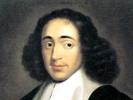
Sacred Texts Philosophy Spinoza Index Previous Next
Buy this Book at Amazon.com


Correspondence, by Benedict de Spinoza, [1883], at sacred-texts.com
[Of the difference between the political theories of Hobbes and Spinoza, of the Unity of God, of the notion of figure, of the book of a Utrecht professor against the Tractatus Theologico-Politicus.]
Most courteous Sir,—As regards political theories, the difference which you inquire about between Hobbes and myself, consists in this, that I always preserve natural right intact, and only allot to the chief magistrates in every state a right over their subjects commensurate with the excess of their power over the power of the subjects. This is what always takes place in the state of nature.
Again, with regard to the demonstration which I establish in the appendix to my geometric exposition of Cartesian principles, namely, that God can only with great impropriety be called one or single, I answer that a thing can only be called one or single in respect of existence, not in respect of essence. For we do not conceive things under the category of numbers, unless they have first been reduced to a common genus. For example, he who holds in his hand a penny and a crown piece will not think of the twofold number, unless he can call both the penny and the crown piece by one and the same name, to wit, coins or pieces of money. In the latter case he can say that he holds two coins or pieces of money, inasmuch as he calls the crown as well as the penny, a coin, or piece of money. Hence, it is evident that a thing cannot be called one or single, unless there be afterwards another thing conceived, which (as has been said) agrees with it. Now, since the existence of God is His essence, and of His essence we can form no general idea, it is certain, that he who calls God one or single has no true idea of God, and speaks of Him very improperly.
As to the doctrine that figure is negation and not anything positive, it is plain that the whole of matter considered indefinitely can have no figure, and that figure can only
exist in finite and determinate bodies. For he who says, that he perceives a figure, merely indicates thereby, that he conceives a determinate thing, and how it is determinate. This determination, therefore, does not appertain to the thing according to its being, but, on the contrary, is its non-being. As then figure is nothing else than determination, and determination is negation, figure, as has been said, can be nothing but negation.
The book, which a Utrecht professor wrote against mine, and which was published after his death, I saw lying in a bookseller's window. From the little I then read of it, I judged it unworthy of perusal, still less of reply. I, therefore, left the book, and its author. With an inward smile I reflected, that the most ignorant are ever the most audacious and the most ready to rush into print. The Christians seem to me to expose their wares for sale like hucksters, who always show first that which is worst. The devil is said to be very cunning, but to my thinking the tricks of these people are in cunning far beyond his. Farewell.
The Hague, 2 June, 1674.